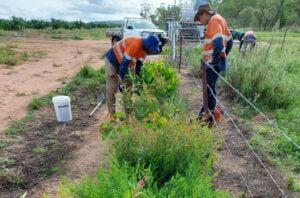02 November 2023
Native pollinators prove powerful
Pollination is essential for flowering plants, but the importance of Australia’s native pollinators is occasionally overlooked.
A trial as part of the Smart Farms Small Grant Powerful Pollinators project is examining these pollinators and their behaviour on-farm.
Janus Boonzaaier, a citrus grower in Dimbulah, Queensland, is taking part in the trial. Janus has planted approximately 300 native trees on his orchard, in the hope of attracting more European and native bees, flies, and other pollinators.
“In the main citrus flowering month, they [the native trees] are not flowering, so that encourages native pollinators to go into the citrus trees rather than into their natural habitat,” Janus said.
“For the rest of the year, the native trees are flowering, so the pollinators stay around the farm.
“It will probably take two or three years for the trees to fully grow and for us to learn if we were correct with our assumptions.”
The beneficial bugs are already playing an important role in Janus’ crop management.
“We’ve definitely seen that having beneficial bugs reduces the need to spray a lot, especially with mealybugs,” said Janus.
“They’re quite hardened, so other pesticides don’t kill them very well, but we tend to spray softer pesticides that don’t kill the beneficials.”
Around 6,000 Star Ruby and Jackson grapefruit trees are planted on Janus’ orchard.
Gulf of Savannah NRM [GSNRM] Intensive Agriculture Project Officer, Sarah Stevens, said the Powerful Pollinators project aims to increase native pollinator numbers and improve the quality and volume of fruit production.
“This will be achieved through improving landholder awareness of the importance of pollinators, encouraging them to use less insecticides and to maintain more pollinator-friendly areas on their farms,” Sarah said.
Low pollination numbers can have an impact on the quality and yield of commercial crops.
“If you provide a habitat inside your orchard and then spray every night or every ten days, you’re sort of bringing these pollinators in then bumping them off,” said Sarah.
“The idea we had with this project was adapted to provide a habitat [for the pollinators] on the edges of the orchards.
“We’re going to avoid spraying in this area and we’re going to provide a year-round feast. Ideally, we hope to see an increase in beneficial and pollination species.”
The trial could result in a greater combination of native plants and insects co-existing within commercial citrus orchards.
“We won’t know if the habitat planting makes any difference to crop production until the trees are mature and flowering,” said Sarah.
“GSNRM hopes to be able to follow up the trials with monitoring in the future.”
Bob Stewart has since stepped into Sarah Steven’s role as the Intensive Agriculture Officer of GSNRM.

Around 300 native trees have been planted on Janus Boonzaaier’s orchard in Dimbulah.
Membership
You are not logged in
If you are not already a member, please show your support and join Citrus Australia today. Collectively we can make big things happen.
